I will be straight up, this spin is my latest amateur attempt to wrap my head around what generative AI is bringing to our world of inclusive, specialized education supports and instructional strategies. As I delve deeper into AI agents, chatbots, and so-called ‘super-intelligent’ supports, I find myself weaving together past experiences, present realities, and future possibilities to make sense of an educational landscape rich with potential yet edged with hesitation.
I'm going to date myself again, travelling back in time to my youth and the era of "Go, Go Gadget." Growing up in the 80s, I was a big fan of the original Inspector Gadget. I remember singing his catchy tune with my younger sister and brother before the latest wacky Gadget cartoon adventures would unfold on NTV. With his robotic mechanisms and the thousands of high-tech gadgets installed in his body, Inspector Gadget would never fail to inadvertently save the day. Between Gadget and his two sidekicks, Penny, the intelligent niece and her resourceful dog, Brain, we loved watching their weekly adventures to overcome Dr. Claw's villainous challenges. I just loved how all Inspector Gadget had do was to say "Go-Go-Gadget" and the right tool would appear to begin solving problems and making life easier. It was awesome.
So how do AI designers, IEPs, the rich diversity of today’s classrooms and Inspector Gadget intersect? I believe teachers need their own “Go-Go-Gadget,” a tool that can support both student and educator needs in a more personalized, efficient, and comprehensive way. That’s where the connection between IEPs and AI design comes into focus. Many would argue this is a slippery slope, and I agree. Sharing sensitive details about a student’s growth and development with an AI platform is not what I’m advocating. Privacy legislation exists for a vital reason: to safeguard personal information and uphold human dignity. What I’m advocating is a more thoughtful use of AI, as a thinking partner or co-designer, that has the potential to be a game changer for educators. By leveraging AI in innovative ways, teachers can more effectively craft long-term goals and actionable short-term objectives for students who thrive with something different.
I also want to be clear: this post is not about finding a fix it for students who learn differently. Our students don't need a fix it, they are unique, amazing individuals with unlimited potential. It’s the instructional practices built around a ‘one-size-fits-all’ model that need the fix. Our adult learning experiences and teaching practices are in constant need of refinement. AI offers that opportunity daily; it’s the ‘Go-Go-Gadget’ tool we’ve been waiting for, right at our fingertips.
So where do we start? We start by being clear this is not a dialogue of repair, this is one of refinement, of doing better because we know better and we have access to innovative technologies that are just a click away. While I admit that conversations with AI experts about the potential for technological replacement in inclusive education can be unsettling, I’m not ignoring the reality of AI’s rapid evolution, I’m choosing to engage with it thoughtfully and critically. I use it daily as a thought partner, it helps me refine and consolidate my messy thoughts in a cohesive manner. AI isn’t replacing the human touch or relational connection in my work, in fact, on the days I get it right, it creates more time for meaningful interpersonal interactions.
In our monthly district inclusive education team staff meeting, we recently delved into a collaborative learning activity using AI to explore our school district's three commitments to educational excellence. Following our district guidelines for using AI, we built out an interactive thinking activity as follows. Our intention was to create a space where professionally we could explore using AI in a more role specific manner. Here’s a snapshot of what we explored, why we focused on this work, and the insights that are shaping the future of AI in inclusive education.
Step 1: Refer to guidelines (When do I use AI?) to determine which level of AI use is acceptable.
We intentionally started here as adult learners because this reflects the expectations for AI use in our classrooms with our students. Guidelines are critical to ensure ethical and responsible usage of AI tools. Users of all ages need to understand the expectations and established parameters for AI engagement in learning experiences. Blanket bans on AI are counterproductive; in today’s digital world, ignoring its presence is unrealistic and avoiding engagement is educationally negligent. Guidelines help AI users maintain academic integrity by encouraging them to critically evaluate outputs and to use AI to complement their thinking, rather than replace creativity or individuality. When we know what’s expected when using AI in our learning, it’s easier to stay organized and make things more efficient where it makes sense.
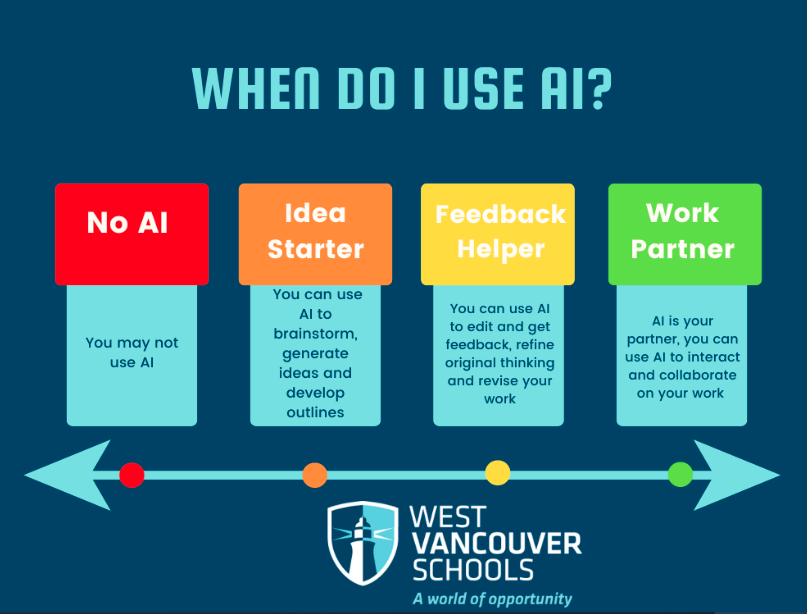
Step 2: Getting started with AI.
Recognizing that there were mixed levels of interactive experience and comfort with AI, we broke the activity down into three starting points followed by introducing macro and micro promoting strategies. Macro prompting and micro prompting refer to different levels of detail and scope when giving instructions to an AI system. Both are important.
Macro prompting sets the overall direction or purpose for using AI. This type of prompting is important in big picture thinking when you are looking for guidance related to higher level responses. An example of this could be: Explain the key foundational skills in literacy development and how they connect to language interventions for diverse learners.
Micro prompting is useful for going deeper when you are looking for more specific responses and control over output. An example of micro prompting is: Create a 30-minute lesson plan for a SLP working with early readers to strengthen phonological awareness. Include objectives, materials, three interactive activities, and a quick assessment idea.
We intentionally encouraged staff to explore both macro and micro prompting to deepen their thinking and refine responses. This exploration aimed to build familiarity with AI’s possibilities and efficiencies—tools that can serve as valuable starting points for educators when designing personalized learning experiences.
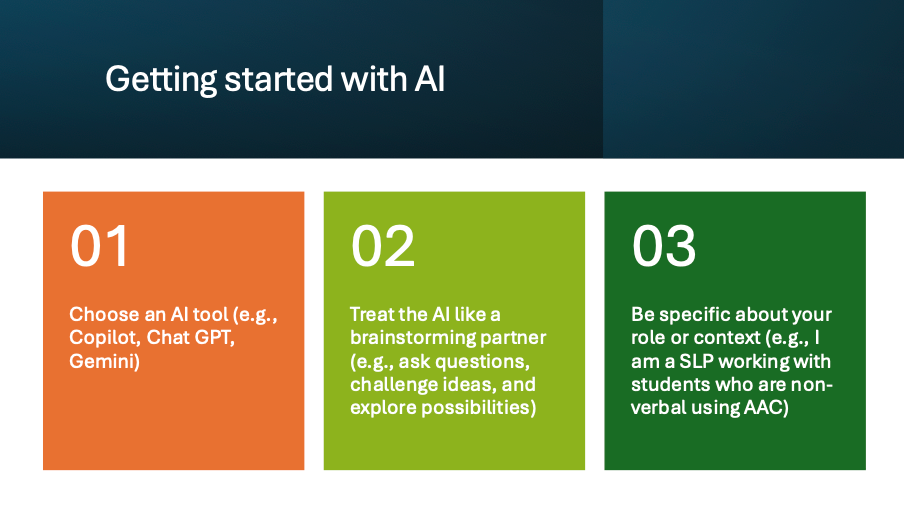
Step #3: We asked our team to choose one of the school district’s three commitments as a starting point and to use one of the suggested prompt questions as an entry point. This wasn’t just an exercise, it was intentional. Our goal was to help staff contextualize these commitments in relation to their area of specialty and current portfolio of work.
Why start here? Because grounding AI exploration in our shared commitments ensures that the technology serves our values, not the other way around. It also gives each professional a meaningful lens for thinking about how AI can support inclusive education.
Our inclusive education team is made up of an incredible group of intelligent, curious professionals. By engaging with prompts tied to district priorities, they weren’t just learning about AI, they were shaping how it could enhance equity, access, and personalized learning for all students.
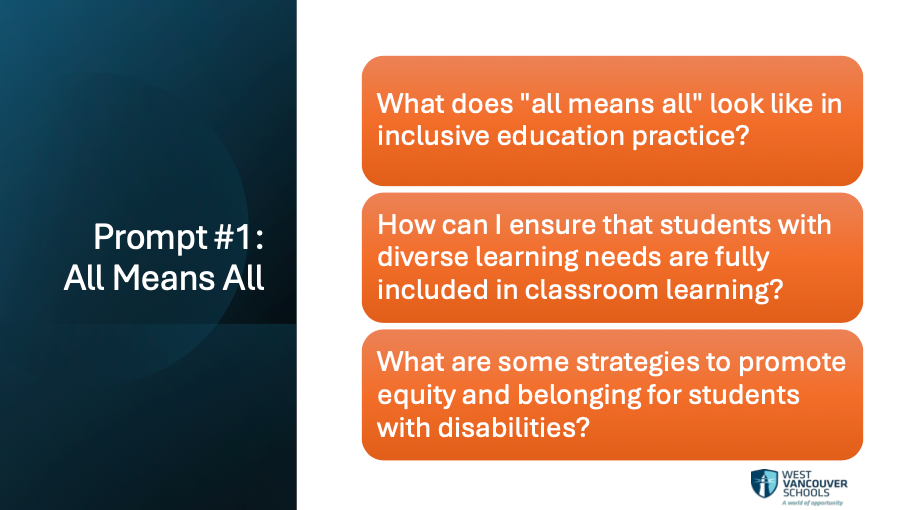
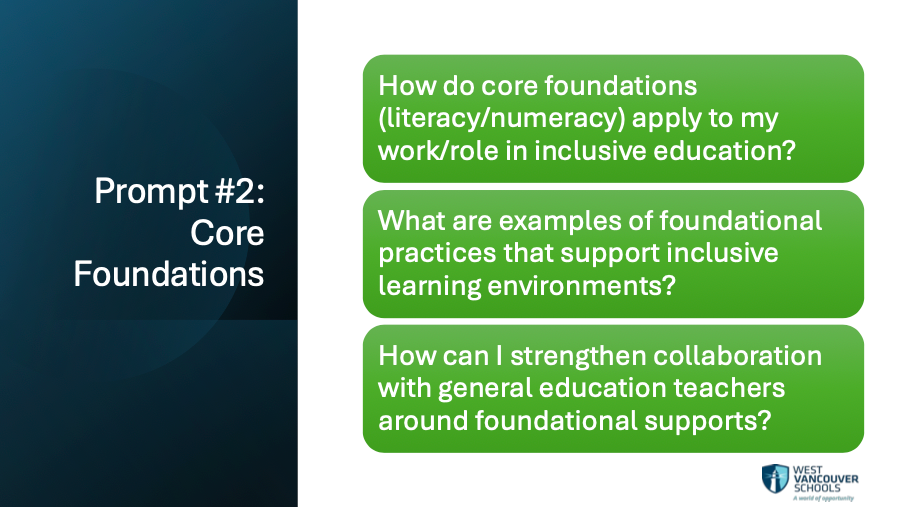
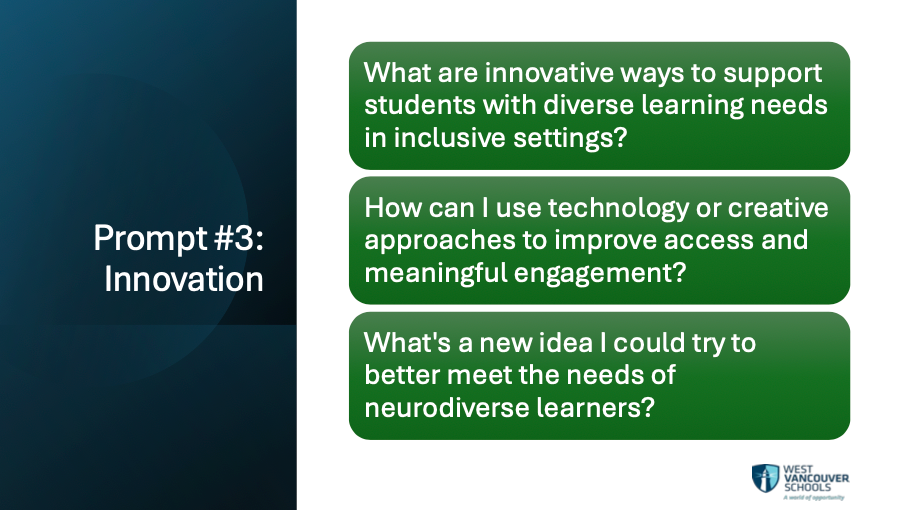
As our team worked through these question prompts, we focused on improving their interactions with AI by encouraging continuous refinement of their micro prompts. Asking AI chatbots, ‘Did I miss anything?’ took the exploration to a deeper level. Different groups found that sometimes the feedback was spot-on, and other times less so, but the process sparked rich conversations about purpose, intention, and practice.
Prior to our staff meeting, I was curious to learn about how our team would receive this experience. Wonderings I held prior to this learning activity included (a) Would using AI as a thought partner be a new experience for some? (b) How would a group of highly skilled professionals engage with AI as a thought partner in their respective speciality areas? (c) Could this interaction with AI lead to improvements in pedagogy and practices to better support our students?
In our post activity debrief I discovered mixed reviews. Some appreciated the activity and its guided exploration as the nudge to give AI the try that they needed. Others raised concerns about the environmental impact of firing AI up for things that we could work through without it. Privacy concerns were also raised regarding areas of specialization and adherence to ethical standards. One point of unanimous agreement in the feedback was that, despite AI’s potential, it cannot replace the value of human connection and meaningful conversation.
There is no doubt that this new educational frontier calls for ongoing exploration. Although this reflection focused on an AI-driven learning experience for district specialist staff, my initial curiosity centered on the development of Individualized Education Plans (IEPs). The activity I described, however, did not delve deeply into the technical process of tailoring educational goals and objectives for diverse learners. I admit I am still guilty of looking for the fix it as I continue to discover IEPs that have poorly written goals and lack actionable, impactful learning objectives. In an era where AI assistance is literally at our fingertips, I admit feeling frustrated knowing that the solution for building a more robust IEPs is just a click away.
As AI tools and their use in education continues to evolve, it is critical that educators contribute to the conversation of how to better the classroom experience for all, students and staff alike. This reflection isn’t about IEP development, though that may come next, but rather about designing an AI-supported experience for staff during a meeting to spark momentum around using AI for ongoing work and efficiencies. I want to be very respectful of colleagues and the complexity of their current work. It is intense and multi-faceted. While much of my daily work is school intensive, and my days as a classroom or learning support teacher are not recent, I do see what is happening to many educators as they try with caring hearts, intelligent minds and immense professionalism to be everything for everyone. Burnout is real and there are ways to soften the harder edges of education. I am not pitching as AI as the fix it or solution to burn out, but I do believe we need to keep finding new ways of working so that the majority of our energy stays where it matters most, on our students and their learning.
I leave this reflection with more questions than answers, knowing that while AI offers incredible possibilities, there’s no "Go, Go Gadget" quick fix, just the ongoing process of learning, experimenting, and figuring things out together as educators in real time.

Author's Note: In the spirit of transparency and academic integrity, I used Copilot, my go-to AI tool, to edit grammatical aspects of this piece for improved readability. As I continue collaborating with my “Go, Go Gadget” AI agents, I value their co-editing capabilities, yet they cannot replace the spark of original ideas or the depth of concept development that requires human judgment.



